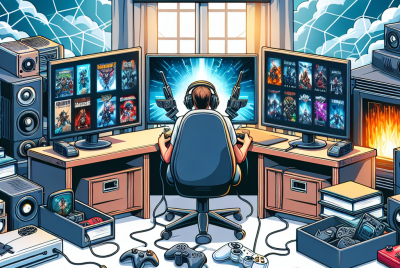Pixelated Memories: Top Games of the 90s That Still Rock
Pixelated Memories: Top Games of the 90s That Still Rock
The 1990s represented a golden era in gaming, laying the groundwork for today’s interactive experiences. With the transition from 8-bit to 16-bit and beyond, countless titles became cultural icons, captivating hearts and minds across the globe. In this article, we’ll explore the top games of the 90s that not only defined a generation but continue to resonate with gamers today.
1. Super Mario 64
Released in 1996 for the Nintendo 64, Super Mario 64 revolutionized 3D platforming. Mario’s move to a fully realized 3D world introduced the concept of free-roaming gameplay, allowing players to explore vast levels filled with hidden secrets and challenging enemies. The game’s innovative use of 3D camera controls and lush environments set new standards for later platformers. Today, Mario’s first polygonal adventure continues to inspire developers and delight players, making it a timeless classic.
2. The Legend of Zelda: Ocarina of Time
Considered by many as one of the greatest games of all time, The Legend of Zelda: Ocarina of Time was released in 1998. It introduced a revolutionary lock-on targeting system and expansive open-world exploration. Players took on the role of Link, as he embarked on a quest to stop the evil Ganon. The game’s richly woven narrative, memorable characters, and deep puzzles captured the imagination of millions, and its influence is still felt in countless action-adventure titles released in subsequent years.
3. Final Fantasy VII
The release of Final Fantasy VII in 1997 marked a significant turning point for Japanese role-playing games (JRPGs) in the West. The game’s cinematic storytelling, complex characters, and expansive world captivated players and introduced them to a darker narrative grounded in environmental themes and existential crises. The turn-based combat system, combined with innovative materia mechanics, provided depth to gameplay. Final Fantasy VII not only cemented its position as a classic but also paved the way for the franchise’s future successes.
4. Sonic the Hedgehog
Sega’s answer to Nintendo’s Mario came in the form of Sonic the Hedgehog, which burst onto the scene in 1991. With its adrenaline-pumping speed and colorful visuals, Sonic offered an entirely different experience that appealed to a more dynamic audience. The game featured distinct level designs and the catchy soundtrack added to its charm. Sonic became an emblematic character of the 90s, and his legacy continues to influence platforming titles and pop culture today.
5. Pokémon Red and Blue
When Pokémon Red and Blue launched in 1996, it sparked a global phenomenon that remains unparalleled. Players could catch, trade, and battle 151 Pokémon, each with its unique traits and abilities. The concept of battling and trading through link cables was revolutionary, and it created a community around the game that profoundly influenced both handheld gaming and social interactions among players. The Pokémon franchise has expanded beyond games into an enduring cultural staple.
6. Doom
Debuting in 1993, Doom brought the first-person shooter (FPS) genre into the mainstream. Its groundbreaking 3D graphics and fast-paced gameplay provided an intense and immersive experience. Players navigated through complex maze-like levels, battling hordes of demons and uncovering secrets. Doom not only inspired countless sequels but also established core mechanics found in modern shooters, contributing significantly to the evolution of multiplayer and online gaming.
7. Street Fighter II
Released in 1991, Street Fighter II is credited with popularizing competitive fighting games and establishing eSports culture. The introduction of diverse characters, each with unique fighting styles and abilities, created a thrilling gameplay dynamic that kept players engaged. Its combo system and multiplayer gameplay paved the way for competitive gaming’s future. The franchise continues to thrive today, with Street Fighter V and upcoming titles keeping the fighting spirit alive.
8. Tetris
While its origins predate the 90s, the version of Tetris released on the Game Boy in 1989 became a defining classic of the decade. Its addictive mechanics and simple yet challenging gameplay ensured that players could quickly pick up and enjoy sessions anywhere. The game’s influence is seen in numerous puzzle titles that followed. Tetris remains relevant, appealing to new generations, thanks to its timeless mechanics and competitive formats like Tetris 99.
9. GoldenEye 007
A landmark title for multiplayer FPS games, GoldenEye 007 was released for the Nintendo 64 in 1997. Based on the James Bond film of the same name, the game featured an engaging single-player campaign and groundbreaking multiplayer modes. Players could compete against friends in split-screen matches, fostering a social gaming environment unprecedented at the time. The innovative use of stealth mechanics and mission objectives showcased a sophisticated approach to FPS design that still resonates in modern games.
10. Castlevania: Symphony of the Night
Launched in 1997, Castlevania: Symphony of the Night redefined the action-adventure genre by introducing RPG elements like level progression and item collection. Players guided Alucard through a vast castle teeming with secrets, character encounters, and a rich gothic atmosphere. Its non-linear exploration and deep gameplay mechanics influenced a massive wave of “Metroidvania” titles, creating a lasting legacy in gaming.
11. Resident Evil
When Resident Evil debuted in 1996, it established the survival horror genre, blending intense gameplay with cinematic storytelling. Players guided characters through a mysterious mansion filled with zombies and intricate puzzles. The atmospheric tension and emphasis on resource management set the stage for later horror games. The franchise’s impact is profound, resulting in numerous sequels, spin-offs, and a lasting legacy within the genre.
12. Myst
In 1993, Myst emerged as a groundbreaking adventure game that captivated players with its stunning visuals and immersive storytelling. Its point-and-click gameplay welcomed players into a mysterious island filled with intricate puzzles and enchanting environments. Myst helped popularize the CD-ROM format, showcasing the potential of multimedia in gaming. It continues to influence narrative-driven games, reflecting the importance of atmospheric storytelling in interactive entertainment.
13. Final Fantasy Tactics
Launched in 1997, Final Fantasy Tactics introduced a new level of depth to strategy RPGs. Set in the beloved Ivalice universe, the game featured an engaging turn-based combat system, intricate character customization, and a mature storyline filled with political intrigue. The combination of gameplay elements from traditional Final Fantasy titles established a strong foundation for future tactical games, making it a beloved classic that still garners attention in today’s gaming landscape.
14. Mortal Kombat
First introducing players to its graphic depictions of combat in 1992, Mortal Kombat became synonymous with brutal finishing moves and distinctive characters, pushing the boundaries of violence in gaming. The series’ unique combination of fighting mechanics and a deep story led to a devoted fanbase. Subsequent iterations have successfully evolved the franchise, cementing its legacy in both gaming culture and competitive fighting scenes.
15. Crash Bandicoot
Launch titles don’t get more iconic than Crash Bandicoot, released in 1996 as a platformer for the original PlayStation. Featuring bright graphics, a quirky titular character, and engaging gameplay, Crash Bandicoot carved its niche and became a symbol of the PlayStation brand. The series continues to evolve with remakes and new titles, bringing the lovable character back to modern consoles and delighting both new and returning fans.
These games from the 90s tell a story of innovation and creativity. Their impact on the gaming landscape is profound, with many influencing modern game design. As technology continues to evolve, the roots planted by these pixelated masterpieces remain steadfast, reinforcing the idea that great games can withstand the test of time.




